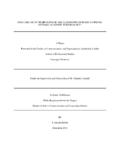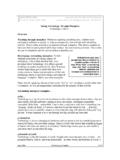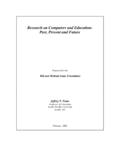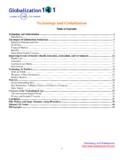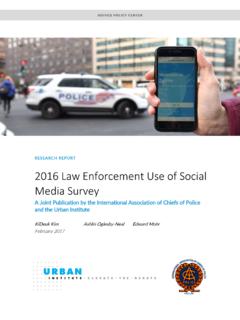Transcription of EFFECTIVE USE OF RECYCLED WATER IN COOLING …
1 EFFECTIVE USE OF RECYCLED WATER IN COOLING TOWERS WITH NEW GREEN technology Joe Walters, West Basin Municipal WATER District, Carson CA Dan Duke, WATER Conservation technology International, Temecula CA Abstract Use of RECYCLED WATER in COOLING towers presents a unique challenge with conflicting goals and characteristics. Ideally, COOLING towers evaporate WATER resulting in two to six cycles of concentration of minerals before a significant portion (17-50%) of the WATER must typically be discharged to waste treatment plants. The cycles of concentration (COC) varies based on the concentration of minerals which cause scale and corrosion of metals. RECYCLED WATER has the added negative characteristic of higher nutrient levels that sustain bacteria growth. As the cycles of concentration increase, the COOLING tower becomes an incubator for bacterial growth that creates biofilms.
2 RECYCLED waters usually have higher mineral content that limits cycles of concentration. This has resulted in other RECYCLED WATER users having to operate at low concentrations, excess blow down and high chemical biocide use to limit biofouling. Use of RECYCLED WATER therefore results in fewer cycles of concentration, two to four times the chemical treatment cost, more discharge volume (increasing quantities of BOD and COD discharged to sewers), lower COOLING efficiency due to biofilm, and more operational cost to clean and maintain the COOLING system. A new green technology , that uses simple filtration and ion-exchange (softened) pretreatment of RECYCLED COOLING tower makeup WATER , was been implemented at a US automotive corporate headquarters. This unique treatment process addresses all of the issues inherent in all COOLING tower make-up WATER systems to enhance efficiency, reduce discharge to the sewer system, dramatically reduce corrosion, and reduce overall WATER usage by enabling cycles of concentration to increase to 50 or greater!
3 This site was ideal for a study of this process as they used potable WATER with this treatment approach prior to converting to RECYCLED WATER . The filtering and softening treatment permit the RECYCLED WATER to be used at dramatically increased TDS levels. As cycles increase several benefits are derived: Silica, naturally present in the WATER , converts to a corrosion inhibitor eliminating the need for chemical corrosion inhibitors, High TDS (study system reached 60,000 TDS) and pH levels prevents bacteriological growth and eliminates the need for toxic biocides to prevent biogrowth, Without scale or biogrowth, energy efficiency of the COOLING system is increased and cleaning costs are reduced, Less WATER is used with dramatic increase in cycles (discharge reduced by 95% or more), Nitrification treatment of RECYCLED WATER is no longer required, and And most importantly, the technology provides an economical process to expand RECYCLED WATER use in COOLING towers that can provide a major WATER -energy sustainability impact in California.
4 Introduction Use of RECYCLED WATER can replace 100% of fresh WATER use in towers, and displace energy cost of $272 / AF (1) consumed to purify and transport fresh WATER . West Basin Municipal WATER District (West Basin) has been a leader in use of RECYCLED WATER in COOLING towers, providing nitrification pretreatment for several large refinery towers. Typical treatment includes nitrification of tertiary disinfected RECYCLED WATER which is later treated with various chemicals by the user to mitigate corrosion and biogrowth. Since nitrification is not cost EFFECTIVE for smaller COOLING towers, some sites have opted to use tertiary disinfected RECYCLED WATER without the nitrification process. While this approach saves money compared to potable WATER or nitrified RECYCLED WATER , increased biogrowth and corrosion potential have required substantial increases in chemical use and operation at lower COC s.
5 Some sites have also encountered higher maintenance costs and reduced efficiency which more than offset WATER savings. These set-backs had the potential to greatly limit the application of tertiary disinfected RECYCLED WATER for small to medium sized COOLING towers until the implementation of a unique treatment process in the central plant of a US automotive corporate facility in 2007. This new green technology uses simple filtration and high efficiency softening (HES) of RECYCLED makeup WATER for COOLING towers. The unique treatment process addresses all of the issues inherent in all COOLING tower WATER systems to enhance efficiency, reduce discharge to the sewer system, dramatically reduce corrosion and scale, mitigate biological fouling, and reduce overall WATER usage by enabling operation of towers at greater than 50 cycles of concentration.
6 Background As commercial and industrial facilities convert to use of municipal RECYCLED or other waste WATER reuse sources to conserve WATER , they will potentially face increased corrosion from higher total dissolved solids (TDS) and ammonia that is corrosion aggressive to copper, copper alloys and other metals. They also face significantly increased biological growth and fouling potentials from RECYCLED waters that contain ammonia, phosphate and organics that support biological activity. Municipal RECYCLED WATER typically contains high levels of ammonia as a result of incomplete removal of this byproduct of human waste in the treatment process. RECYCLED WATER also contains residuals of phosphate from soaps and detergents, residual organic contaminants, as well as increased TDS residuals.
7 Chemical treatment of COOLING tower waters that contain ammonia, organics and phosphates is challenging and expensive, as it requires significant increases in the quantities of traditional inhibitors and biocides used to control corrosion and bio-fouling. Such WATER quality also generally requires increased tower WATER wastage to avoid scale limitations. These traditional WATER treatment issues have reportedly been the major limitation and resistance to increasing use of RECYCLED WATER in evaporative COOLING applications. Over the past five years, a new technology has permitted COOLING towers to operate at zero blow down (ZBD), and maintain TDS levels between 10,000 and 150,000 mg/L without hardness or silica scales. The patented treatment process discussed in this paper mitigates scale, corrosion or biological fouling problems (4-6).
8 Establishing this process as an EFFECTIVE and economical approach to facilitate use of RECYCLED and other wastewater sources, by mitigating traditional treatment limitations, will further expand WATER conservation alternatives. Establishing the viability of silica-azoles chemistry for application in ZBD tower systems using RECYCLED WATER (typically containing high TDS, ammonia, organics, and phosphates) becomes very relevant for the industry. Corrosive attack of copper by ammonia in WATER is well known in the WATER treatment industry, and presents a particular challenge for reuse of wastewater sources that contain ammonia in COOLING tower systems. Many of these systems use copper and copper alloys which are vulnerable to ammonia. Ammonia in WATER exist in equilibrium as both the ammonium ion and ammonia gas in the pH 7 to 11 range.
9 The equilibrium shifts toward increased ammonium ion concentration as pH approaches 7 and to increased ammonia gas concentration as pH approaches 11. Thus, ammonia gas can be volatilized from WATER by pH elevation, heat and circulation over a COOLING tower, typical of commercial ammonia stripper design. ZBD chemistry naturally controls tower WATER at greater than pH 9, and causes ammonia/ammonium ion residuals to be reduced to lower ranges by such tower stripping. Increasing azoles concentration improves copper corrosion inhibition, but such improvement is time and concentration dependent at acidic or neutral pH (less than 9). These nitrogen containing inhibitors are referred to as azoles in the WATER treatment industry, and include the commonly applied tolytriazole (TTA), BTA, and variations of chemical structure that produce comparable inhibiting films on metal surfaces.
10 Studies by WATER Conservation technology International (WCTI) have determined that application of azoles in COOLING towers, with control of pH between 9 to 10 in high TDS and low hardness WATER , contributes to more rapid and highly protective film formation to protect copper and copper alloys from corrosion by ammonia. This high TDS and low hardness chemistry results from evaporative concentration of natural makeup WATER minerals, following HES softening of potable, surface or RECYCLED waste WATER sources used for makeup to COOLING towers treated with the patented methods (2, 6) described in this paper. Silica-azoles Chemistry The silica corrosion inhibitor chemistry discussed in this paper has been described in previous publications (4-6). The chemistry has proven to be exceptionally EFFECTIVE in inhibiting corrosion of all metals commonly used in evaporative COOLING WATER systems.
